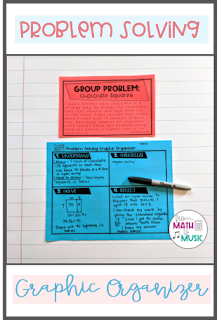Problem-Solving in the Math Classroom - Part 1 - What is problem solving?
Teaching students to think and talk about math does not come naturally. So much of math education has been about rote learning - which definitely has a place. Taking a problem-solving approach to your math program can be unnerving for the teacher, students and especially the parents. We all have to struggle through but I saw firsthand the growth in my students so I wanted to share with you how I got problem-solving started in my class.
You don't have to reinvent the wheel. Joe Roicki from Math Musings has a really great unit plan on how to launch a Mathematical Community. It is based on the Week of Inspirational Math by Jo Boaler and I totally recommend checking it out! It is what I used from Day 2 of the school year and really shaped my students' attitudes about math. A lot of this lesson is based on Joe's with a few tweaks to fit with what I like to do in my math program.
Discuss what they think some characteristics of a problem solver might be (everyone can learn math, mistakes are valuable, growth mindset) versus a problem performer (just wants to get an answer as quickly as possible).
Create a T-chart with one heading being Problem Solver and the other Problem Performer. Read 2-3 of the cards linked above and model which category the card would fall under. Send the students off to their table groups with their own sorting cards and chart paper. I have the groups just place the cards on the paper so I can reuse them later. Afterwards, the students reconvene at the carpet and we take up their solutions.
You don't have to reinvent the wheel. Joe Roicki from Math Musings has a really great unit plan on how to launch a Mathematical Community. It is based on the Week of Inspirational Math by Jo Boaler and I totally recommend checking it out! It is what I used from Day 2 of the school year and really shaped my students' attitudes about math. A lot of this lesson is based on Joe's with a few tweaks to fit with what I like to do in my math program.
1. Create an anchor chart
Have students Think-Pair-Share about what comes to mind when they hear the term "problem solving." Write all ideas down on a piece of chart paper. I loved seeing the different viewpoints my students had!2. Use a read-aloud - Good Night Owl by Greg Pizzoli
Explain to the students that this book is all about an owl with a problem. Read the book but pause periodically to let students share their thoughts about whether Owl is being a problem solver or not. (Joe uses a video about Ormie the Pig that goes over well with students, too).3. Sort the characteristics of a Problem Solver and a Problem Performer
Click here for the sorting cards from Joe.Discuss what they think some characteristics of a problem solver might be (everyone can learn math, mistakes are valuable, growth mindset) versus a problem performer (just wants to get an answer as quickly as possible).
Create a T-chart with one heading being Problem Solver and the other Problem Performer. Read 2-3 of the cards linked above and model which category the card would fall under. Send the students off to their table groups with their own sorting cards and chart paper. I have the groups just place the cards on the paper so I can reuse them later. Afterwards, the students reconvene at the carpet and we take up their solutions.
4. Quick Write
I use a lot of Quick Writes in my math program. Sometimes they are journal prompts where students just have to write about their thinking in response to a lesson. Other times, they are a series of short questions that they can choose 2 or 3 to answer. My students were not given a text book which meant a lot of their independent practice was created by me. That's what worked for us! My students had a regular 8.5x11 notebook, the grid paper kind, and would glue the Quick Writes into it. When printing off the questions I would usually have 3 per page and then cut the questions into strips to give to my kids. It saves paper and I like that. Click here for a free version of the Quick Write I used to consolidate their learning.
"Good mathematics isn't about how many answers you know...it's about how you behave when you don't know."
Author Unknown
What does this quote mean to you? Use the terms "problem solver" and "problem performer" in your response.
Ready for Part 2 of my Problem Solving Series?Click here to learn how to teach your students how to use a problem solving graphic organizer.









Thanks for the shout out! I love your perspective on building a problem solving community!
ReplyDeletefragjucrib-ki Joshua Faria https://marketplace.visualstudio.com/items?itemName=6epomtral-bi.Tick-Tack-Puppet-gratuita
ReplyDeleteberrehulti
lisabis_a Edward Clarke Autodesk Maya
ReplyDeleteKerish Doctor
FixMeStick
benmahorar
This blog post on problem-solving in the math classroom is insightful and practical! The strategies discussed here offer a fresh perspective on approaching mathematical challenges. I particularly appreciate how the methods are broken down step-by-step, making complex problems more manageable. Incorporating such techniques into Maths Tuition sessions could greatly benefit students by enhancing their problem-solving skills and confidence.
ReplyDelete